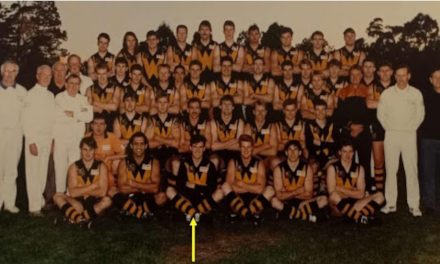Veteran AFL umpire Ray Chamberlain is set to retire at the end of the 2024 season. Photo: AFL MEDIA
It was the announcement of the retirements of some senior umpires this week which made me think about of a curious recent phenomenon going on in AFL football.
Most footy fans would be well-acquainted with “Razor” Ray Chamberlain, who is giving it away at the end of this season after having umpired 385 games and three grand finals. Plenty would be familiar with the name Chris Donlon, too, after 422 games and a grand final.
But it struck me upon reading the brief tributes afforded the pair, along with a retiring boundary umpire, 300-gamer Michael Saunders, that there’s not too many more whistle-blowers these days with whom we are familiar.
Off the top of my head, I can name the experienced likes of Brett Rosebury, Matt Stevic, Matthew Nicholls, Simon Meredith and Leigh Fisher. But that doesn’t feel like many in a group now comprising 43 field umpires at the start of this season.
Even among that group, “Razor Ray” is perhaps the only thing even remotely close to a household name.
And that’s a lot different to even the 1980s and 1990s, I’d argue, when, from a far smaller group, you had the likes of Bill Deller, Glenn James, Rowan Sawers, John Sutcliffe, John Russo, Kevin Smith, Bryan Sheehan, Peter Carey, Peter Cameron, Darren Goldspink, Hayden Kennedy, Steve McBurney, Shane McInerney, Scott McLaren, and plenty of others well-known, again, right off the top of the head.
That’s certainly in contrast to virtually any other group of stakeholders in the game, like players, coaches, even administrators, not to mention the ubiquitous player managers whose profiles have all risen steeply with the saturation coverage of the game these days.
I’m sure that reflexively, most footy fans would agree that’s a good thing, too. You know, best seen and not heard etc. But I’m not sure that in the broader context, it necessarily is a positive.
For all some fans’ whingeing about Chamberlain over the years along the lines of “trying to make himself the centre of attention” etc., you can’t help but notice in the footage of him in action the quality of his relationships with players, born out of mutual respect.
And that is really only a contemporary version of the sorts of relationships those umpires of older eras enjoyed with the players on field as a rule, not just as the odd exception to a more anonymous, officious persona which tends to make the craft very much a matter of “us” and “them”.
Media was central to that sense of knowing the umpires, too. The likes of Deller, Cameron and Russo, later on in an official commentary role with Channel 7, somehow made the umpires and art of umpiring more relatable.
PLEASE HELP US CONTINUE TO THRIVE BY BECOMING AN OFFICIAL FOOTYOLOGY PATRON. JUST CLICK THIS LINK.
But in the flood of former players into media roles and with it often an accompanying swaggering sense of machismo, umpires are cast regularly as the nerdy stamp collectors of the football world, the subjects of sniggering, the greater anonymity now arguably making it easier for fans to dole out the abuse without thought or care.
It certainly can’t help the public perception at a time when umpiring the game has never been more difficult, an already thankless task made even harder by the introduction of many new rules and responsibilities.
That’s an important point, too. When fans are going crook at umpires, often it’s not the enforcers of the rules with whom they should be taking issue, but the rule-makers.
“In any game, an umpire has to process something like 3000-odd transactions. They’re constantly adjusting, they’re constantly umpiring, there’s no such thing as a dead part of the game for an umpire,” former 300-game umpire Dean Margetts explained on 3AW last weekend.
“We’ve lost sight of the fact there’s so much happening in our game from crowd noise to the game itself, the contest, the courage of the players. The umpires are making adjudications every second of that, and I reckon nine times out of 10 they do a pretty damn good job, and sometimes we need to acknowledge that.”
Frankly, given the sort of opprobrium with which they regularly deal, let alone actually receiving any kudos, it’s a wonder football attracts as many umpires as it does. But recruitment is a looming issue for AFL football, let alone at the grass roots.
The retirements of Chamberlain and Donlon will rob the AFL umpires’ list of a collective 800-games plus experience. That will hurt. But the bigger issues might actually be at the other end of the experience chart.
In 2004, 20 years ago, the senior AFL umpiring list was 28-strong and had an even balance of experience ranges, around 35 per cent of the panel with more than 100 games experience or less than 50 games, and the group in-between around 29 per cent.
This year, there’s 43 umpires on the list. But more than 50 per cent of them have more than 100 games AFL experience under their belts, with the 0-50 gamers comprising only 28 per cent, and 50-100 games only 21 per cent.
Are enough of them lasting long enough to become the Chamberlains and Donlons of tomorrow? And who could blame them if they didn’t, given their job is tougher now than it ever used to be, seemingly more stressful, and less likely the source of external validation?
I think the game should know more of these guys better than it does. And it should certainly appreciate more the job they do.
This article first appeared at ESPN.











